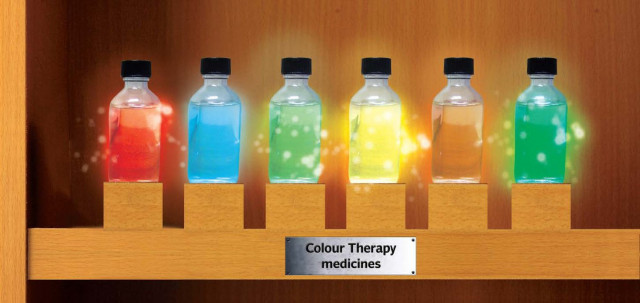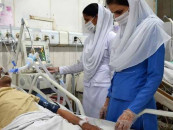Colour me better

Feng Shui experts and fashionistas have long plugged red for romance and blue for tranquility. But now a small number of therapists in Pakistan are turning to colour or chromotherapy to actually treat illnesses.
Colour therapist and a PhD in clinical hypnotherapy Dr Aliya Aftab explains that they take the position that the human body is made up of seven colors or ‘chakras’ and each colour is associated with a different body organ. A deficiency or excess of any colour in the body is what causes different illnesses for which colors can be used as treatment.
“The main concept of using colours for therapy is to work with their healing properties,” she told The Express Tribune. For instance, green is used on people who may be stressed as it has a soothing property. People come to Aftab mostly with complaints of depression, stress and anxiety. She has even treated children with attention-deficit disorder and self-confidence issues. The young and the old can be treated through colour hypnosis, a meditative technique, in which patients are asked to imagine a particular colour being absorbed by their bodies.
Physically the patients need to incorporate different colours in their daily lives. For instance, people with depression are asked to use blue bedsheets or curtains, she said. “Water therapy is another very important aspect of colour therapy, in which, bottles of different colours are filled with water and kept out in the sun for a few days,” she explained. When the first few ultraviolet rays from the sun hit the water, it starts to absorb the bottle’s colour and as a result becomes therapeutic. For example, the colour yellow can treat stomach problems. Red can energise.
That said, however, colour therapy is new. Aftab claimed she gets about six patients a day. The type of people who explore this avenue are those who do not want a quick fix that involves popping a pill. “They want something new that can bypass that bland taste in their mouths, thanks to all those antibiotics,” she said.
Colour therapist Waqar Yousuf Azeemi, who runs a clinic in Nazimabad, confirmed that he also gets patients mostly suffering from depression, insomnia, stomach disorders and heart conditions. “We treat them with water therapy and distinct types of meditation with colour,” he said.
Why and how does it work?
Consider this. In the Journal of Acupuncture and Meridian Studies, Pakistani researchers published a paper in 2008 on the effects of visible range irradiation on enzyme solutions in order to look at changes produced in the human body after chromotherapy. The glucose solution showed enhanced activity to the colour purple while the activity of the other enzymes increased when exposed to dark violet. Purple is being used in conventional chromotherapy for diabetes and is believed to work on the oxidation of glucose. They wrote that specific wavelengths regulate living processes by acting as catalysts in enzyme activity.
Put much more simply: “Colours are a sign of life,” said Yogi Wajahat, who was a mechanical engineer for 23 years but was drawn to this new field. “ I used to earn for myself before but now I earn with the satisfaction that I help people,” he said. His therapy programme includes the ‘milky white light’ meditation, which is done by imagining a white beam of light coming directly from the sky and touching the person. He claimed that this technique has worked well with many of his patients who had anger problems. “Colour therapy can give amazing results,” he claimed, advising that it can even be used in a positive way in homes and environments. “Lush green plants everywhere can affect people and their behavior, they will be calmer and less frazzled,” he said. Take schools, for example. They can use colours to attract students rather than drive them away.
Chromotherapy doesn’t just mean painting your house the right colour. There have been technological advancements that use lasers for better and swifter results. “The laser has an accurate frequency and wavelength of colour that can give quick results,” said Dr Kaleem Ahmed Baig, a colour therapist who claims that he has had a recovery rate of 60 to 70 per cent. His patients mostly have problems such as migraine, stomach ulcers and psychological trouble. His therapy programme includes the use of milk, instead of water. The combination is kept out in the sun for two days with a wooden base underneath it and given to patients as medication. Dr Baig also felt that people are turning towards alternative methods of therapy because high-powered medication is proving to be devastating for their health in the long run. “The success rate of colour therapy is noticeable because it can directly stimulate the endocrine glands,” he claimed.
What do people say?
The Express Tribune caught up with the mother of a girl who benefited from colour therapy. “Fatima nearly drowned [once] and since then she was not able to breathe on her own and suffered from other complications as well,” said her mother Aliya. The family lives in Riyadh and went to Lahore in search of alternative treatments. Fatima went to one therapist who used a combination of treatments which included the use of coloured lights on her body. “[He] used a blue light on Fatima’s head for an hour or two during which she used to cry initially but eventually it started to work,” her mother claimed. “She came to Lahore on a stretcher but went back sitting properly in a seat.”
Another enthusiast is Asim, whose mother Zubaida could not walk due to partial paralysis. “I had to be there for my mother all the time because she was not able to do anything without my assistance,” he said. The family had tried neuropathic drugs but they did not help her and the side-effects were even more painful.
Just before they gave up, they went to a therapist who used different coloured lights on her legs, including red, which is allegedly used for energy. “I believe my mother recovered from many deficiencies in her body from colour therapy and now she walks and does things on her own,” said Asim.
Colour therapists may be gung-ho about its future, but this relatively new field has its sceptics. “I would strictly recommend people to go for colour therapy along with using orthodox medicines,” advised Dr Mubashara Khan, who believes that colour therapy works but cannot be used to replace actual medicines. Also, there is no official backing for this type of treatment and studies or research with proven results in the local context are scarce. There is, however, plenty of published material on the subject. And there are a number of studies have elaborated the relationship between the human body and colors. Researchers from the department of physics at the University of Balochistan Quetta, explained chromotherapy as a method of treatment that uses the visible spectrum (colours) of electromagnetic radiation to cure diseases. A few researchers have tried to discover the underlying scientific principles, but without quantitative study, they found. And no, blue and green pills don’t count as colour therapy just yet.
REPORTING BY AMNA KHAN
Published in The Express Tribune, July 30th, 2010.



















COMMENTS
Comments are moderated and generally will be posted if they are on-topic and not abusive.
For more information, please see our Comments FAQ